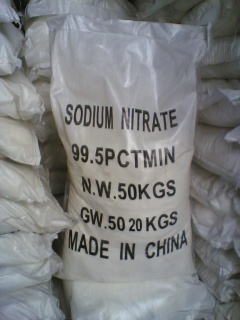Difference between revisions of "Sodium nitrate"
(Created page with "{{Infobox_Miscellaneous | image = Sodium nitrate.jpg | origin = Chili, Peru | stowage factor = ...") |
m |
||
| (3 intermediate revisions by the same user not shown) | |||
| Line 2: | Line 2: | ||
| image = Sodium nitrate.jpg | | image = Sodium nitrate.jpg | ||
| origin = Chili, Peru | | origin = Chili, Peru | ||
| − | | stowage factor = <ul><li>1,39/1,97 m<sup>3</sup>/t (bulk)</li><li>0, | + | | stowage factor = <ul><li>1,39/1,97 m<sup>3</sup>/t (bulk)</li><li>0,99 m<sup>3</sup>/t (bagged) |
| − | | humidity and moisture = | + | | humidity and moisture = - |
| − | | ventilation = | + | | ventilation = No |
| − | | risk factors = | + | | risk factors = See text |
}} | }} | ||
| + | __TOC__ | ||
| + | ==Description / Application== | ||
| + | Sodium nitrate is the chemical compound with the formula NaNO3. This salt is also known as Chile saltpeter or Peru saltpeter (due to the large deposits found in each country) to distinguish it from ordinary saltpeter, potassium nitrate. The mineral form is also known as nitratine, nitratite or soda niter. <br><br> | ||
| + | Sodium nitrate comprises colourless, transparent, odourless crystal; very soluble in water. It is a readily available source of the nitrate anion (NO3-), which is useful in several reactions carried out on industrial scales for the production of fertilizers, pyrotechnics and smoke bombs, glass and pottery enamels, food preservatives, and solid rocket propellant. It has been mined extensively for these purposes.<br><br> | ||
| + | ==Shipment / Storage / Risk factors== | ||
| + | Although non-combustible, mixtures with combustible material are readily ignited and may burn fiercely. This cargo is hygroscopic and will cake if wet. To be separated from foodstuffs. <br><br> | ||
| + | {| | ||
| + | |- | ||
| + | |style="width:150px;"| | ||
| + | |style="width:150px;"| | ||
| + | |- | ||
| + | | Melting point | ||
| + | | 308°C. | ||
| + | |- | ||
| + | | Boiling point | ||
| + | | 380°C, decomposes | ||
| + | |- | ||
| + | |}<br><br> | ||
| + | |||
| + | The product is listed as a dangerous commodity in the IMDG Code. Also consult the IMSBC Code (International Maritime Solid Bulk Cargoes Code) and applicable MSDS sheet. | ||
| + | |||
| + | [[Category: Products]][[Category: Oil and chemicals]] | ||
Latest revision as of 15:07, 13 August 2014
| Infobox on Sodium nitrate | |
|---|---|
| Example of Sodium nitrate |  |
| Facts | |
| Origin | Chili, Peru |
| Stowage factor (in m3/t) |
|
| Humidity / moisture | - |
| Ventilation | No |
| Risk factors | See text |
Sodium nitrate
Description / Application
Sodium nitrate is the chemical compound with the formula NaNO3. This salt is also known as Chile saltpeter or Peru saltpeter (due to the large deposits found in each country) to distinguish it from ordinary saltpeter, potassium nitrate. The mineral form is also known as nitratine, nitratite or soda niter.
Sodium nitrate comprises colourless, transparent, odourless crystal; very soluble in water. It is a readily available source of the nitrate anion (NO3-), which is useful in several reactions carried out on industrial scales for the production of fertilizers, pyrotechnics and smoke bombs, glass and pottery enamels, food preservatives, and solid rocket propellant. It has been mined extensively for these purposes.
Shipment / Storage / Risk factors
Although non-combustible, mixtures with combustible material are readily ignited and may burn fiercely. This cargo is hygroscopic and will cake if wet. To be separated from foodstuffs.
| Melting point | 308°C. |
| Boiling point | 380°C, decomposes |
The product is listed as a dangerous commodity in the IMDG Code. Also consult the IMSBC Code (International Maritime Solid Bulk Cargoes Code) and applicable MSDS sheet.











